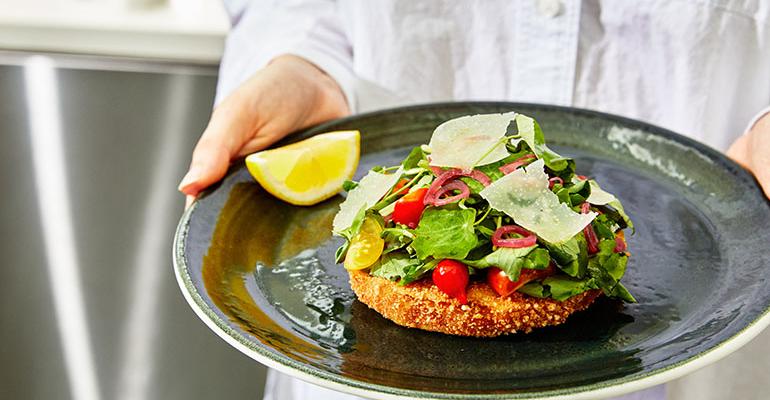In recent years we’ve seen a huge upsurge in the availability of plant-based meat analogs in the marketplace. Often made with pea protein, these vegetarian substitutes for beef, chicken, dairy, and even seafood have substantial marketing dollars behind them, but sales in the U.S. have either stagnated or declined in recent years, depending on what data you look at.
Meanwhile, consumer interest in eating less meat is on the rise. A 2021 study by research firm One Poll commissioned by Sprouts Farmers Market found that 47% of Americans define themselves as “flexitarian,” meaning they do or want to eat more meatless meals than meaty ones. The number of vegetarians also is creeping up to between 5% and 6%, up from around 4% before the pandemic.
To satisfy the growing interest in vegetarian meals, many chefs are going straight to the source and bringing vegetables to the center of the plate.
“I think a lot of people are moving toward a plant-based diet,” said Jenn Crovato, the chef of 1310 Kitchen & Bar in Washington, D.C. She said she was struck by the number of vegan items she saw on menus during a recent visit to the West Coast, and some of her own customers have expressed an interest in meatless items, too.
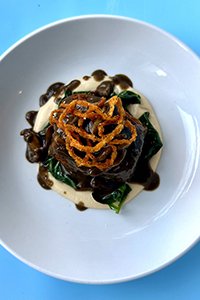 Although she said she had been happy to respond to vegan customers’ dietary preferences in the past, she realized that creating specific meatless entrées removed the guesswork for guests, who wouldn’t have to wonder if they would be accommodated at her restaurant.
Although she said she had been happy to respond to vegan customers’ dietary preferences in the past, she realized that creating specific meatless entrées removed the guesswork for guests, who wouldn’t have to wonder if they would be accommodated at her restaurant.
So she developed a hearty eggplant entrée in the style of a short rib.
She starts by cutting off the top and bottom of a whole eggplant, rubbing it with olive oil and then charring it over an open flame. Then she scrapes off the skin and coats it in a rub that includes cumin, mustard seed, garlic powder, onion powder, paprika, mushroom powder, thyme, cayenne pepper, and kosher salt. Then she braises it with red wine for about an hour and a half. She serves it in a bordelaise sauce made with a combination of fresh mushrooms and rehydrated dry ones — fresh shiitakes and a dried combination of porcini and other wild mushrooms — added to a vegan roux made with flour and Violife vegan butter alternative, plus vegetable stock, which is then all blended together.
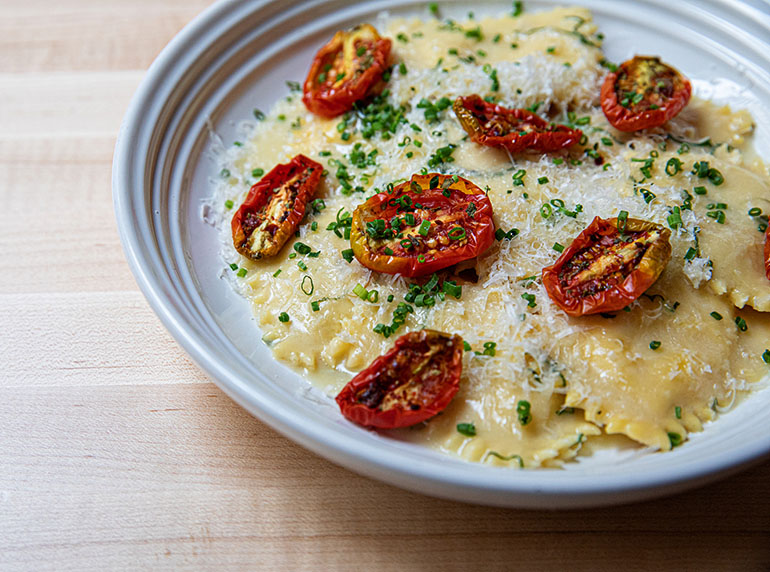
The corn ravioli at Indaco's Greenville, S.C., location was a top seller this summer.
Crovato said using dried mushrooms helps her manage costs, and she added that the water used to rehydrate them also makes a great stock.
This is Crovato’s first vegan dinner entrée on 1310’s menu, although she has a vegan burger made with mushrooms, beans, and rosemary, plus beets or color and ground oats to bind it together.
She’s also working on vegan bar items, including nachos in a sauce made with onions, carrots, and potatoes, which she sautés and then purées with cashews and nutritional yeast.
“I would totally eat a bunch of tortilla chips with it, and feel a lot better afterwards” than if it were a cheesy sauce, she said.
For Josh Begley, executive chef of the Greenville, S.C., location of Indaco, a four-unit Italian concept, vegetable-centric items are a way to support local farmers and highlight the menu’s seasonal nature.
His corn ravioli has been a top seller this summer, he said. “The idea is to use corn all the way.”
He starts by cutting South Carolina corn off the cob and then cooking it in butter with paprika, cream, and thyme for an hour or two in a preparation similar to Southern style creamed corn. Then he mixes it with ricotta cheese, Parmesan and egg yolk and uses that for ravioli filling.
Separately, he makes a broth out of the corncobs by simmering them in water for a couple of hours and then straining the liquid.
The broth is then heated with some butter and Parmesan cheese and the cooked ravioli are added to that. Then it’s plated with oven-dried tomatoes, chives, and more Parmesan.
“South Carolina has great corn and we just wanted to show that off,” he said.
He just recently added a wood-fired pepper dish to the menu, using baby bell peppers that he roasts to blister the skin, and then serves them with toasted pine nuts, pickled Fresno chiles and a salsa verde of basil, parsley, olive oil and chile flakes.
They’re plated over feta cheese blended with heavy cream and lemon juice.
“It’s the same kind of thing as the corn ravioli — just showing off the end-of-the-season peppers coming in,” he said.
Begley said he was surprised by how popular those meatless dishes have been. “The city of Greenville really loves them, and they’re into supporting their farmers,” he said.
At ElNico, a Mexican restaurant that opened this spring in the Penny Hotel in the Brooklyn, N.Y., neighborhood of Williamsburg, executive chef Fernanda Serrano wanted to create a mole that was different from the heavy chocolatey variety that trend-forward Americans have grown accustomed to.
Mexico has many different varieties of mole, and for her meatless option Serrano went with one from the town of Taxco in Guerrero state called mole rose.
To make it she combines tahini with beet powder, seeded habanero pepper, lemon juice, garlic, toasted cumin, and water, blending it until its creamy but not watery.
Next she roasts beets over kosher salt until tender but still firm. She cools them, peels them, and then slices them thinly.
Separately, Serrano blends together seeded habaneros and kumquats with lemon zest and salt and emulsifies the mixture with olive oil.
She spreads the pink tahini mixture in a circle on the serving plate and tops it with a ball of shaved fennel seasoned with salt and lemon juice. That’s dressed in the habanero-kumquat mixture.
Next she forms slices of the roasted beet into parachute shapes and covers the fennel ball with them. She sprinkles them with pine nuts and then garnishes the dish with shiso leaves, fennel tops, olive oil, and Maldon salt.
Serrano said mole traditionally must contain a combination of fruit, nuts, and chile, and with the combination of pine nuts, kumquats, and habanero, this one fits the bill.
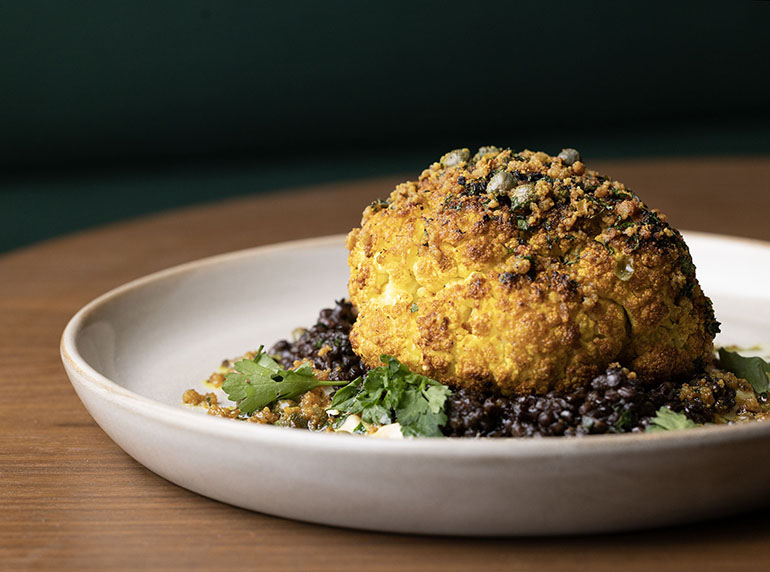
The cauliflower entrée at Alder & Ash in Seattle get more heft with added lentils.
Cauliflower has become an increasingly popular center-of-the-plate vegetable, and Blake Lord-Wittig, executive chef of Alder & Ash in Seattle, gives it more heft and protein by pairing it with lentils.
He rubs a cauliflower head with olive oil and a vadouvan curry blend, marks it on the grill and then roasts it in the oven until it’s tender.
Separately, he cooks cauliflower in coconut milk and then purées it, seasoning it with salt, and in another pot he simmers black lentils with mirepoix and more vadouvan spice.
He makes a dairy-free version of brown butter by cooking coconut milk slowly, for more than an hour, until the solids separate and turn brown. Then he adds capers, the same vadouvan spice blend, tarragon, parsley, mint, lemon juice and salt.
He places the cauliflower purée in the center of the plate, spoons the lentils on top and then adds the roasted cauliflower, finishing it with the coconut sauce.
It’s garnished with mint and parsley.
“We’re taking an ingredient that’s familiar and elevating it into something new,” he said via email. “The dish packs a punch of flavor from the vadouvan spice and has a perfect balance of fat and acidity from the coconut brown butter.”
It makes sense to focus on plants at Yellow Magnolia Café, which is at the Brooklyn Botanic Garden in New York City.
This past spring it offered a celery root Milanese, a meatless variation of the popular breaded and fried chicken Milanese, developed by a team comprised of Union Square Events, a division of Danny Meyer’s Union Square Hospitality Group, and onsite operator Restaurant Associates.
For that dish, celery root was peeled and cut into planks just over ¼-inch thick and poached in a court-bouillon seasoned with a little turmeric and some other aromatics until tender. Then the planks were dried, breaded in unseasoned breadcrumbs, and pan-fried until golden brown. Then they were seasoned with Maldon salt and topped with a lemon-caper aïoli that had some grated Parmesan cheese folded in.
The dish was topped with a salad of watercress, nasturtium flowers, baby heirloom tomatoes, pickled Sweety Drop peppers, pickled red pearl onion rings, basil leaves, and shaved Parmesan cheese. Finally, it was finished with more Maldon salt and extra virgin olive oil and served with a lemon wedge.
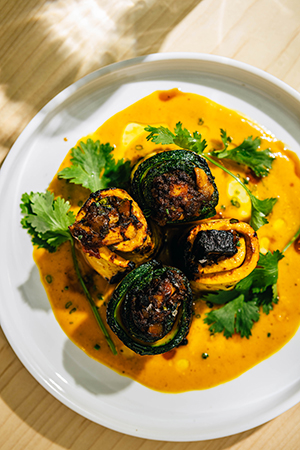 At Ajja restaurant in Raleigh, N.C., chef Cheetie Kumar took an already vegetarian dish, makdous — a Lebanese cured and stuffed eggplant — and made it seasonal while also doing away with the two-week curing period by using local summer squash. She combinedtoasted walnuts with garlic, long chiles, “tons of parsley,” harissa, and some grilled squash. That mixture and halloumi cheese were stuffed into hollowed out zucchini, which was then grilled. It was dressed with a saffron infused yellow tomato and yellow pepper vinaigrette developed by chef de cuisine Scott McKenney.
At Ajja restaurant in Raleigh, N.C., chef Cheetie Kumar took an already vegetarian dish, makdous — a Lebanese cured and stuffed eggplant — and made it seasonal while also doing away with the two-week curing period by using local summer squash. She combinedtoasted walnuts with garlic, long chiles, “tons of parsley,” harissa, and some grilled squash. That mixture and halloumi cheese were stuffed into hollowed out zucchini, which was then grilled. It was dressed with a saffron infused yellow tomato and yellow pepper vinaigrette developed by chef de cuisine Scott McKenney.
Vegetables aren’t alone in the plant kingdom when it comes to anchoring a savory menu item. Fruit can work too, such as the lychee ceviche at Musaafer, an Indian restaurant in Houston. This spring chef Mayank Istwal cured lychee in kokum, an extract from young mangosteen — a beautiful tropical fruit with a red or purple skin and milky white fruit inside — that’s used as a souring agent. He then sliced the lychee and plated it with a sauce of coconut milk, ginger, and yuzu. Then he dressed it in curry leaf oil and Kashmiri chile oil and topped it with watermelon radish cut into star shapes, house-made corn nuts, dyed red onion, cilantro stalks, and serrano chile. He finished it with a combination of candied green papaya and watermelon rinds.
Contact Bret Thorn at [email protected]

